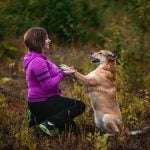Training your dog to act around a baby is essential for creating a safe and harmonious environment for both your furry friend and your new bundle of joy. Dogs are loyal and loving creatures, but they may need guidance on how to interact appropriately with a baby.
This introductory section will explore the importance of training your dog to act around a baby and provide an overview of the steps you can take to ensure a positive relationship between your dog and baby.
Bringing a baby into your home is an exciting time, but it can also be a period of adjustment for your four-legged family member. Dogs are sensitive to changes in their routines and environments, so it’s crucial to lay the foundation for a smooth transition before the baby arrives. By training your dog in advance, you can set clear boundaries and establish rules that will promote safety and create a sense of calmness when the baby finally arrives.
This article will guide you through various stages of training, from preparing your dog for the arrival of a baby to teaching them how to behave calmly and responsibly around their new human sibling. We will cover important topics such as supervised interactions, addressing potential behavior issues or concerns, incorporating positive reinforcement, and creating a safe environment for both dog and baby.
By implementing these training techniques, you can build a strong relationship between your dog and baby that will last for years to come.
Preparing Your Dog for the Arrival of a Baby
Preparing your dog for the arrival of a baby is an essential step in ensuring a smooth transition for both your furry friend and your new family member. Dogs are highly adaptable, but it is important to properly introduce and acclimate them to the changes a baby brings. Here are some tips and tricks to help you prepare your dog for the arrival of a baby.
- Gradual Exposure: Start by gradually exposing your dog to different sounds, scents, and sights associated with babies. You can play recordings of baby noises or allow your dog to sniff baby items such as blankets or toys. This will help familiarize them with these new stimuli before the actual arrival of the baby.
- Set New Boundaries: It is crucial to establish new boundaries and rules for your dog before the baby arrives. This may include designating certain areas as off-limits or teaching commands like “leave it” or “stay.” By setting clear expectations, you can help prevent any potential issues that may arise when the baby comes home.
- Practice Desensitization: Familiarize your dog with common actions that occur around babies, such as using strollers, rocking chairs, or carrying a doll in your arms. This will help them adjust to these movements and reduce any anxiety they may have when encountering them for the first time with a real baby present.
| Tips | Tricks |
|---|---|
| Gradual Exposure | Set New Boundaries |
| Practice Desensitization | – |
Remember, every dog is unique, so it’s important to tailor your approach to your dog’s individual needs and temperament. Consistency, positive reinforcement, and patience are key when preparing your dog for the arrival of a baby. By taking these steps, you can help ensure a harmonious and safe environment for your entire family.
Establishing Boundaries and Rules for Your Dog Before the Baby’s Arrival
Before your baby arrives, it is crucial to establish clear boundaries and rules for your dog. This will help create a foundation of obedience and ensure the safety and well-being of both your dog and your baby. Here are some tips on how to accomplish this:
- Reinforce basic commands: Review and reinforce basic commands such as sit, stay, down, leave it, and come. Practice these commands in different situations and gradually increase the distractions to ensure that your dog responds reliably.
- Set up baby-related areas: Create designated areas where your dog is not allowed to enter, such as the baby’s nursery or play area. Use baby gates or other physical barriers to restrict access. Start implementing these boundaries before the arrival of the baby so that your dog can get used to them.
- Establish a routine: Dogs thrive on routines, so establish a consistent schedule for feeding, walking, and playtime. By sticking to a predictable routine, your dog will feel more secure and less likely to act out due to anxiety or frustration.
| Tips for Establishing Boundaries |
|---|
| Reinforce basic commands |
| Set up baby-related areas |
| Establish a routine |
By implementing these tips before the arrival of your baby, you are creating an environment that promotes calmness and respect between your dog and the new addition to your family. With clear boundaries in place, you are setting both your dog and baby up for success in their future interactions.
Additionally, consider enrolling in obedience training classes with your dog to strengthen their obedience skills further. These classes can provide valuable guidance and support from professional trainers who are experienced in training dogs to interact safely with children.
Remember, it is important to start early and be consistent with your dog’s training. This will help your dog understand their role in the family dynamic and ensure a smooth transition once the baby arrives. By establishing boundaries and rules beforehand, you can create an environment where both your dog and baby can coexist harmoniously.
Introducing Your Dog to the Baby in a Controlled and Safe Environment
Once you have prepared your dog for the arrival of a baby and established boundaries and rules, it is time to introduce your furry friend to the newest member of your family. It is important to approach this introduction in a controlled and safe environment to ensure a positive experience for both your dog and baby.
- Prepare the environment: Before bringing your baby home, make sure the space is comfortable for both the dog and the baby. Create a designated area for the baby where they will be safe from accidental interactions with the dog. This can be achieved by using playpens or baby gates.
- Associate positive experiences: Start by allowing your dog to sniff items that belong to the baby, such as blankets or clothing, before introducing them directly. This will familiarize the dog with the baby’s scent and help them associate positive experiences with it.
- Controlled introductions: When introducing your dog to the baby, it is essential to remain calm and composed. Keep your dog on a leash initially, maintaining control over their movements. Allow them to approach at their own pace while keeping a close eye on their body language for signs of stress or aggression.
- Reward good behavior: Whenever your dog displays calm behavior around the baby, reward them with praise, treats, or affection. Positive reinforcement will reinforce these desirable behaviors and help create an association between good behavior and rewards.
- Gradual exposure: Gradually increase exposure between your dog and baby over time in short sessions. Monitor closely for any signs of discomfort or anxiety in either party. If necessary, consult with a professional trainer or behaviorist for guidance on gradually increasing interaction between them.
By introducing your dog to the newborn in a controlled and safe environment while providing positive reinforcement, you are laying down foundations for building a harmonious relationship between them. Remember that patience and consistency are key throughout this process as it may take time for your dog to adjust to the new addition to the family.
Teaching Your Dog How to Behave Calmly and Responsibly Around the Baby
One of the most important aspects of preparing your dog for the arrival of a baby is teaching them how to behave calmly and responsibly around the new addition to the family. This not only ensures the safety and well-being of your baby but also helps in creating a positive bonding experience between your dog and child. Here are some key tips for training your dog to behave around the baby:
First, it’s crucial to teach your dog basic obedience commands such as “sit,” “stay,” and “leave it.” These commands will come in handy when you need to control your dog’s behavior around the baby. Practice these commands on a regular basis so that they become second nature to your furry friend.
Additionally, expose your dog gradually to situations involving babies or young children. Start by simulating sounds such as crying or babbling using recordings, while rewarding calm behavior with treats or praise. Gradually introduce your dog to real-life interactions with infants in a controlled and supervised manner. This helps them understand that they need to maintain their composure around babies and encourages positive associations.
Furthermore, create positive associations between your dog and all things related to the baby. Allow them to sniff baby items like blankets, clothing, or toys while giving them treats or rewards. This helps your dog associate these objects with pleasant experiences rather than feeling threatened or anxious when they encounter them.
Remember, consistency is key when training your dog. Establishing a daily routine that includes spending quality time with both your dog and baby can help create harmony in their interaction. Structured activities such as walking together or playing gentle games can also help reinforce positive behavior.
By implementing these strategies, you can ensure that your furry companion learns how to behave calmly and responsibly around the new addition to the family. With patience, consistency, and proper training techniques, you’ll be able to build a strong relationship between your dog and baby, fostering a loving and safe environment for everyone involved.
Supervising Interactions Between Your Dog and the Baby
Ensuring the safety of both your dog and your baby is crucial when they interact. Supervision is key to prevent any accidents or unwanted behavior. Here are some dos and don’ts to follow when supervising interactions between your dog and the baby:
Dos:
- Always be present: Never leave your dog and baby alone together, especially in the early stages. Even if you trust your dog, it’s important to be there to intervene if necessary.
- Be calm and confident: Dogs are perceptive creatures that can pick up on our emotions. Stay calm and composed during their interactions, as this will help your dog remain relaxed as well.
- Set clear boundaries: Establish rules for both your dog and baby. Teach your dog to respect personal space by creating designated areas where they can relax without being bothered.
Don’ts:
- Force interaction: It’s essential to let the interaction between your dog and baby happen naturally. Forcing them into proximity can cause stress or fear for either party.
- Punish or scold: If your dog displays undesirable behavior, avoid punishing or scolding them in front of the baby. This can create a negative association between them, potentially leading to aggression or anxiety.
- Allow rough play: Rough play should never be tolerated between dogs and babies. Make sure to discourage any overly enthusiastic behavior from either side.
Remember, every dog and baby dynamic is unique, so adjust these dos and don’ts according to their individual needs and personalities. Keeping a watchful eye on their interactions while promoting positive experiences will help foster a safe bond between your dog and baby over time.
Addressing Potential Behavior Issues or Concerns
Identifying Behavior Issues
When it comes to training your dog to act around a baby, it is important to address any potential behavior issues or concerns that may arise. Aggression, fear, and anxiety are common issues that some dogs may experience when they are introduced to a new baby. Identifying these issues early on can help prevent any mishaps or negative interactions between your dog and the baby.
Seeking Professional Help
If you notice signs of aggression, fear, or anxiety in your dog during the introduction or interactions with the baby, it is recommended to seek professional help from a certified dog trainer or behaviorist. These experts have the knowledge and experience to assess your dog’s behavior and provide appropriate guidance and training techniques tailored to your specific situation.
Implementing Positive Reinforcement Techniques
Positive reinforcement techniques can be highly effective in addressing behavior issues such as aggression, fear, or anxiety. Reward-based training methods that focus on praising and rewarding desired behaviors can help your dog associate positive experiences with the presence of the baby. This approach can gradually change their perception and reactions towards the baby over time.
Gradual Exposure and Desensitization
One effective technique for addressing fear or anxiety is gradual exposure and desensitization. Start by exposing your dog to the sight and scent of the baby from a distance while maintaining a calm atmosphere. As your dog becomes more comfortable, you can gradually decrease the distance between them and allow supervised interactions under controlled circumstances. It is essential to proceed at a pace that ensures your dog feels safe and secure throughout the process.
Avoid Punishment
It is crucial to avoid punishing your dog for displaying aggression, fear, or anxiety around the baby. Punishment can exacerbate these behavior issues and create a negative association between the dog and the baby. Instead, focus on positive reinforcement and reward-based training methods to encourage desired behaviors and gradually eliminate any unwanted ones.
By addressing potential behavior issues or concerns promptly and implementing the appropriate training techniques, you can help your dog overcome any aggression, fear, or anxiety they may have towards the baby. This will not only create a safer environment for both your dog and your baby but also foster a harmonious relationship between them as they grow together.
Incorporating Positive Reinforcement and Reward-Based Training Techniques
When training your dog to act around a baby, it is important to use positive reinforcement and reward-based training techniques. These methods are effective in teaching your dog the appropriate behaviors around the baby, while also strengthening the bond between them.
Positive reinforcement involves rewarding your dog for displaying desired behaviors. This can be done through praise, treats, or playtime. For example, if your dog remains calm and gentle around the baby, give them lots of verbal praise or a tasty treat. By associating good behavior with positive rewards, your dog will learn to repeat those behaviors in order to receive positive reinforcement.
Reward-based training techniques also involve using a clicker or marker word, such as “yes” or “good,” to indicate when your dog has done something correctly. You can pair this marker with a treat or other reward immediately after they perform the desired behavior. Over time, your dog will understand that the marker means they have completed a behavior successfully and will be rewarded for it.
It is crucial to be consistent and patient when incorporating positive reinforcement and reward-based training techniques. Set clear expectations for what you want from your dog in each scenario involving the baby, and provide rewards consistently for good behavior. Remember that learning takes time and repetition, so continue to reinforce these behaviors throughout the training process.
By using positive reinforcement and reward-based techniques in training your dog around a baby, you are not only teaching them how to behave appropriately but also creating a positive association between them. This will help build trust and strengthen their relationship over time, creating a safe and harmonious environment for both your dog and baby.
Creating a Safe and Peaceful Environment for Both Dog and Baby
Designating Pet-free Zones
One of the important steps in creating a safe environment for your dog and baby is to establish designated pet-free zones in your home. These areas will serve as private spaces for your baby where they can play and sleep without any interference from the dog. It is important to choose areas that are easily accessible for the baby but not easily accessible for the dog.
This can be achieved by using baby gates or installing door locks to keep certain rooms off-limits to your dog. By creating pet-free zones, you not only ensure the safety of your baby but also give your dog some space of its own where it can relax undisturbed.
Baby-proofing Your Home
Before the arrival of your little one, it is crucial to baby-proof your home to minimize potential risks or accidents involving both your dog and baby. Look out for any hazards that could harm either party, such as exposed electrical cords, toxic plants within reach, or low furniture that can be toppled over. In addition, make sure all cleaning supplies and chemicals are stored securely out of reach from both pets and children.
Furthermore, consider investing in outlet covers and cabinet locks to prevent access to potentially dangerous items. By creating a safe environment free from hazards, you can have peace of mind knowing that both your dog and baby are protected.
Maintaining a Routine
Dogs thrive on routine, so it is essential to maintain a consistent schedule even after the arrival of a baby. Changes in household dynamics can cause stress or anxiety for your furry friend, so keeping their daily routine intact can help them feel secure and balanced. Make sure they receive regular exercise sessions and meal times at consistent intervals throughout the day.
Additionally, ensure that they have their own designated time for attention and play, separate from the time you spend with your baby. By maintaining a routine that includes quality time with your dog, you can help prevent any feelings of neglect or jealousy that may arise when diverting attention to the new addition.
By implementing these strategies and taking proactive measures in managing your home setup, you will create a safe and peaceful environment for both your dog and baby. The proper management of designated areas, along with thorough baby-proofing and maintaining a consistent routine, will help ensure the well-being and harmony of all family members.
Remember, it may take time for your dog to adjust to the changes, so be patient and provide plenty of positive reinforcement as they adapt to their new role in the family.
Conclusion
In conclusion, training your dog to act around a baby is crucial for building a strong and positive relationship between them. By following the tips and tricks mentioned in this article and using proper training techniques, you can ensure that your dog behaves calmly and responsibly around the baby. This not only keeps the baby safe but also creates a peaceful environment for both dog and baby.
Preparing your dog for the arrival of a baby is an important step. Establishing boundaries and rules beforehand will help your dog understand their place in the family hierarchy and prevent any potential behavior issues from arising. Introducing your dog to the baby in a controlled and safe environment is key to ensuring a smooth transition. Gradual exposure, positive reinforcement, and supervised interactions will help build trust between them.
Supervising interactions between your dog and the baby is crucial to maintain safety. It is important to remember the dos and don’ts when it comes to their interactions. Addressing any potential behavior issues or concerns such as aggression, fear, or anxiety is also essential. Seeking professional help if needed can provide guidance in handling these situations effectively.
By incorporating positive reinforcement and reward-based training techniques, you can encourage good behavior in your dog around the baby. Consistency and patience are key throughout the training process. Additionally, creating a safe and peaceful environment by managing the home setup helps ensure that both dog and baby feel comfortable.
Overall, proper training techniques play a vital role in building a strong relationship between your dog and baby. With patience, consistency, supervision, and positive reinforcement, you can create an environment where they can coexist peacefully and harmoniously. By implementing these techniques early on, you are setting up both your dog and baby for a lifetime of companionship and love.
Frequently Asked Questions
How do I calm my dog around my baby?
Calming a dog around a baby requires a gradual and patient approach. First, ensure that your dog is well-exercised and mentally stimulated to reduce any excess energy or anxiety. Introduce your dog to the baby in a controlled environment, allowing them to observe each other from a safe distance. Use positive reinforcement by rewarding your dog for calm behavior near the baby, such as sitting or lying down.
Supervise all interactions between your dog and the baby, providing guidance and redirection if necessary. Gradually increase their time together, always prioritizing safety and never forcing the dog into uncomfortable situations. Consistency and positive associations between the dog and the baby will help build trust over time.
How do I get my dog to bond with my baby?
Bonding between a dog and a baby can be fostered through several strategies. Start by creating positive associations for your dog with the baby’s presence, such as giving treats or praise when they are nearby during playtime or feeding sessions. Engage your dog in activities involving the baby, such as supervised walks together or gentle petting sessions while talking calmly to both of them.
Encourage gentle interactions between them but always prioritize the safety of both the baby and the dog. Never leave them alone unsupervised until you are confident in their bond. Remember that bonding takes time, so be patient and allow their relationship to develop organically.
How do you stop a dog from being aggressive to babies?
Addressing aggression towards babies requires careful management and training techniques under professional guidance if necessary. Start by identifying any triggers for aggressive behavior, such as loud noises or sudden movements around babies, and work on desensitization exercises gradually over time to help reduce these triggers’ impact on the dog’s behavior.
Implement consistent rules, boundaries, and an obedience training program with positive reinforcement techniques to establish clear expectations for appropriate behavior around babies. Seek professional assistance from an experienced trainer or animal behaviorist who can assess the specific situation thoroughly and provide tailored advice based on your dog’s individual needs.

Welcome to the blog! I am a professional dog trainer and have been working with dogs for many years. In this blog, I will be discussing various topics related to dog training, including tips, tricks, and advice. I hope you find this information helpful and informative. Thanks for reading!





